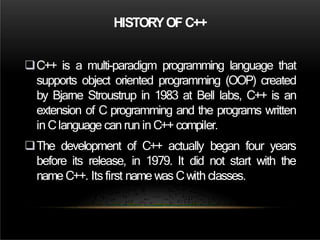C++ is an object-oriented programming language that was created as an extension of C programming language. It was created by Bjarne Stroustrup in 1979 at Bell Labs. Some key features of C++ include support for object-oriented programming concepts like inheritance, polymorphism, and encapsulation. C++ also supports functions, arrays, pointers, and file handling. It is commonly used for system software, drivers, servers, and applications like video games.



























![ARRAYS
Array is defined as a set of homogeneous data items. An Array
is a group of elements that share a common name that are
differentiated from one another by their positions within the
array.
It is a data structure which allows a collective name to be given
to agroup of elements which all have the sametype.
Syntax
datatype arrayname[array size];
The Array which is declared as above is called single-dimension
array](https://image.slidesharecdn.com/cppt-1702180539031-230104061808-67ee2705/85/cppt-170218053903-1-pptx-28-320.jpg)
![Example: float salary[10];
float
salary
[10]
data type
array name
array size(integer)
Thesize of anarray mustbeaninteger constant and
the data type can be any valid C++ data type.](https://image.slidesharecdn.com/cppt-1702180539031-230104061808-67ee2705/85/cppt-170218053903-1-pptx-29-320.jpg)
![ARRAYINITIALIZATION
In C++elements of an array can be initialized one by one or
using asingle statement
float balance[5]={1000.0, 2.0, 3.4,7.0, 50};
The number of values between braces { } cannot be larger than
the number of elements that we declare for the array between
square brackets [ ].](https://image.slidesharecdn.com/cppt-1702180539031-230104061808-67ee2705/85/cppt-170218053903-1-pptx-30-320.jpg)





![C++ STRINGS
The following declaration and initialization create a string
consisting of the word "Hello". To hold the null character at the
end of the array, the size of the character array containing the
string is one more than the number of characters in the word
"Hello.“
Method1: char greeting[6] ={'H', 'e', 'l', 'l', 'o', '0'};
Method2: char greeting[] ="Hello";](https://image.slidesharecdn.com/cppt-1702180539031-230104061808-67ee2705/85/cppt-170218053903-1-pptx-36-320.jpg)

![#include
<iostream.h> int
main ()
{
char greeting[6] ={'H', 'e', 'l', 'l', 'o', '0'};
cout <<"Greeting message: ";
cout <<greeting << endl;
return 0;
}
OUTPU
T
OUTPUT
Greetingmessage: Hello](https://image.slidesharecdn.com/cppt-1702180539031-230104061808-67ee2705/85/cppt-170218053903-1-pptx-38-320.jpg)

![#include<iostream>
#include<cstring>
int main() {
char str1[10] ="Hello";
char str2[10] ="World";
char str3[10];
int len;
strcpy( str3, str1); // copystr1intostr3
cout <<"strcpy( str3, str1) : " <<str3<< endl;
strcat( str1, str2); // concatenatesstr1 andstr2
cout <<"strcat( str1, str2): " <<str1<< endl;
len =strlen(str1); // total length of str1 after concatenation
cout <<"strlen(str1) : " <<len << endl;
return0;
}](https://image.slidesharecdn.com/cppt-1702180539031-230104061808-67ee2705/85/cppt-170218053903-1-pptx-40-320.jpg)




![FILEREADOPERATION
#include<conio.h>
#include<fstream.h>
int main()
{
char c,fname[10];
cout<<"Enter file name:";
cin>>fname;
ifstreamin(fname);
if(!in)
{
cout<<"FileDoes not Exist";
getch();
return0;
}
cout<<"nn";
while(in.eof()==0)
{
in.get(c);
cout<<c;
}
getch();
}](https://image.slidesharecdn.com/cppt-1702180539031-230104061808-67ee2705/85/cppt-170218053903-1-pptx-45-320.jpg)
![FILEWRITEOPERATION
#include<iostream.h>
#include<stdio.h>
#include<conio.h>
#include<fstream.h>
int main()
{ char c,fname[10];
ofstreamout;
cout<<"Enter File name:";
cin>>fname;
out.open(fname);
cout<<"Enter contents to store in file (Enter # at end):n";
while((c=getchar())!='#')
}
{ out<<c;
out.close();
getch();
return 0; }](https://image.slidesharecdn.com/cppt-1702180539031-230104061808-67ee2705/85/cppt-170218053903-1-pptx-46-320.jpg)